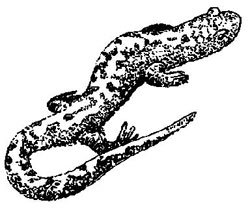Was that something that seemed to be worthy subject to pursue later on?
No, I don’t think so. It was something that was right there at hand and as far as I was concerned, the end of the investigation. There is an interesting sidebar to that. Don and I wanted to have the Crater Lake newts looked over by a man who knew more about amphibian taxonomy than we did. We also wanted a collaborator for the paper. The individual that we picked out was the logical choice from the standpoint of his location. That was Bob Storm at Corvallis (8). Don wrote to Bob and asked him if he would be willing to collaborate with us and examine the Crater Lake newts. In other words, to be our amphibian authority on them. We asked him to be third author on our paper. Do you know that we never heard from him at all (9)? It was on that basis, then that we shipped the newts to the herpetologist at the University of Kansas, Edward Taylor.
I wondered about that connection.
Well, Don had been on the faculty at the University of Kansas. He took the job there right after he got out of the Army. He went from there to Washington State in Pullman, and was in contact with Edward Taylor through his association with the University of Kansas. It was through that contact that these newts were then shipped to Taylor. I was leaving the park at that point, so I could stop over in Lawrence and work with Taylor. That’s exactly what I did, and Taylor looked them over. Actually, he just sort of glanced at them. He didn’t of over them very carefully at all, and by no means looked at all of them. He saw only a few and then gave us his advice on what to do with them.
Was that while you were still at the University of Missouri?
I was just heading for the University of Missouri.
You mentioned over the phone about your appointment at the University of Oregon. How did Ralph Huestis play a role in that?
Well, do you know that Ralph Huestis played a very prominent role in my getting the job here? He and his wife, Geraldine, visited the park the first summer that I was there. He met me at that time. He must have realized that old Jim Kezer was the man for his department, so he offered me a job at the University of Oregon which I had to turn down because I had already signed a contract with the University of Missouri. I told him that if another job opened up here I would certainly be interested in applying for it. Sure enough it did. Another job opened up and that was how I finally came to the University of Oregon.
What year was that?
It was around 1954.


